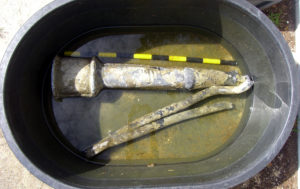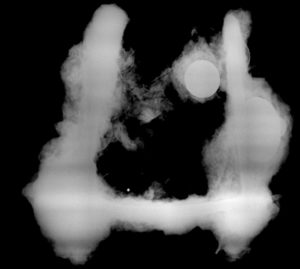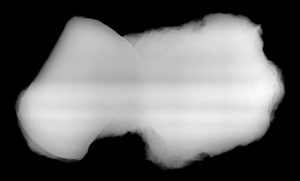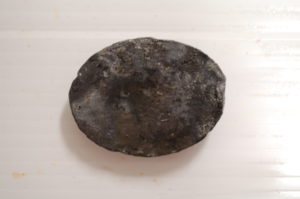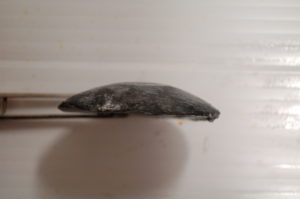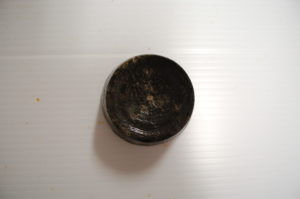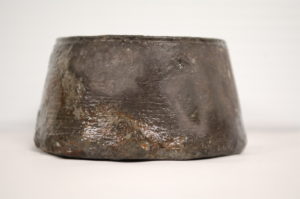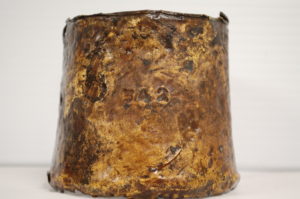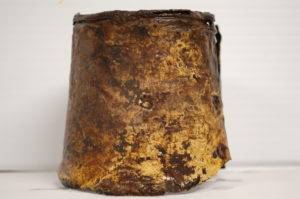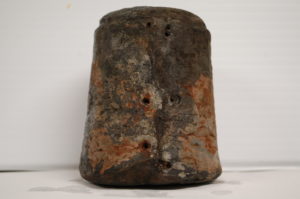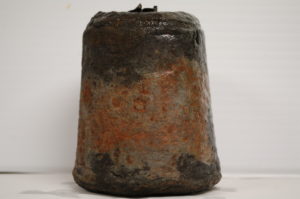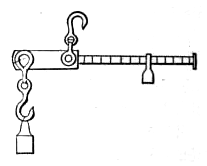Perhaps the easiest material to recognize while conserving is lead.
It is easily distinguishable when excavated and handled due to its extreme density. Divers mostly know when they are picking up lead versus cast iron. None more so than the large deck pump recovered in 2011, which weighs nearly 300 pounds.
Lead artifacts are also easy to pick out after excavation during the X-ray process. They show up as bright white objects. While not always identifiable, the imagery is always undeniable that it is lead.
Recently, I chose a few objects from the previous LAMP field seasons on the Storm Wreck to begin conservation. I specifically singled out these concretions for their lead contents.
The first item is an oblong looking piece that was attached to a larger artifact we have provisionally called a “staple”, due to the resemblance of a giant version of the ubiquitous office supply. I removed the sediment and shell from the exterior of the artifacts and separated them.
We are not exactly sure what the lead artifact is that came out.
The best guess right now is what is referred to as a spoon weight. Lead is either melted in a crucible and poured into or heated directly in the spoon and dumped out when cool. Most likely, this was made to be a fishing weight or some other small line weight, but there are no evident holes or other means of attaching the lead.
The second object was all on its own in the X-ray. Just looking at the artifact, it was easy to tell that it was some sort of measurement weight. The cleaning process was straightforward and easy, as lead typically does not build up a large layer of concretion.
However, because lead is such a soft and malleable metal, extra care was taken when airscribing the debris off. Once clean, I discovered markings cast into or stamped on the top of the lead.
The “P 4” matches the actual weight of the artifact of four pounds. It is unclear at this time what the measurement purpose for the weight is.
The final artifact is the most interesting and the most confusing of the lead objects so far. In the X-ray there is a clear image of a conical lead item concreted to a cannonball. In order to more easily clean the lead, I separated the pieces using an airscribe.
When working on the lead, I expected a similar outcome like the four pound weight previously mentioned. Instead, I uncovered something unexpected. After removing the exterior concretion, I found the lead had a brass sheath or wrap around it.
The brass was in two parts. One piece covered the outside and was tacked into the lead to keep it in place. The other part was a small cap on the top of the weight, which was held down by the larger sheet wrapped around the outside.
After I removed all the concretion I noticed there were markings stamped into the brass. The number 342 is clearly evident on one side and a small, as yet unidentified, mark is on the opposite side.
It is unclear what either marks mean. The numbers most likely refer to the weight in some manner, but may possibly be a serial number or something else entirely. The lead weighs slightly over seven pounds and so far no units of measurement convert into a match.
The small mark, on the other hand, is most likely a maker’s mark or a proofing stamp. Unfortunately, preliminary research has not yielded any similar markings.
One of the more confusing aspects of the artifact concerns the markings on the lead weight itself. Again, the same small unidentified mark is one side and the 342 is on the opposite, matching those stamped into the brass. However, where the marks are on the lead do not coordinate with how the brass wrap was situated on the lead.
By looking at how the brass was tacked onto the lead one can see that the markings do not overlap each other, but are instead offset by quite a bit. It is possible that the brass and lead were stamped at the same time and then the exterior covering was just shifted over before being nailed in.
However, there appears to be another digit at the end of the 342 on the lead, but is difficult to read. This same marking shows up on the brass precisely where one of the tacks was used to hold the cover in place. This suggests that the lead and the brass were marked at different points or the brass was incorrectly stamped.
As for the purpose of the artifact, that has yet to be determined as well. On the top of the lead there would have been a small iron ring or loop. The iron has almost completely corroded away, but the holes in the lead remain. This implies that the weight was meant to hang, rather than sit on a scale like the four pound weight. The presence of the brass could mean that it was used to protect the lead from getting scuffed up. It could also suggest that it was meant to look nicer and be more presentable.
One possible explanation is that the artifact is a clock weight, similar to those found in grandfather clocks or clockwork mechanisms. Unfortunately, the shape of the weight may negate that possibility. Clock weights are typically long, thin and cylindrical so they occupy less space. The conical shape of the artifact would not be ideal for that type of use.
Another possible answer may be that the object was used as part of an apparatus called a steelyard. This type of hanging scale uses a beam with a sliding counterweight in order to measure. The artifact may be the movable counterweight, but more research needs to be conducted.
Next time you’re visiting the museum, take a guided Lost Ships tour with one of our archaeologists and you can see these lead pieces along with other artifacts from the Storm Wreck.
Andrew Thomson is the Assistant Conservator for the St. Augustine Lighthouse & Museum. He received his graduate degree and training from the Conservation Research Laboratory at Texas A&M.


